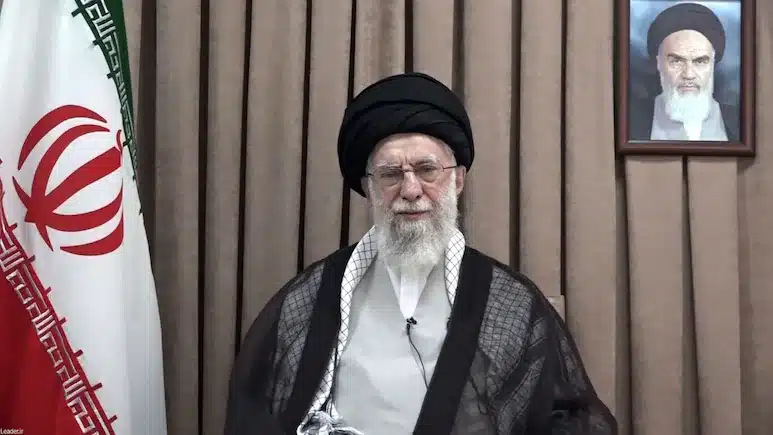As tensions soar in the Middle East, Iran’s Supreme Leader Ayatollah Ali Khamenei has delivered a fiery response to the United States’ latest airstrikes on Iran’s nuclear sites. With powerful language and bold symbolism, Khamenei’s words underscore a larger message of defiance, warning, and the regional ripple effects of a growing military confrontation.
Iran’s Supreme Leader Reacts to U.S. Strikes: ‘The Zionist Enemy Is Being Punished Right Now’
Iran’s supreme leader, Ayatollah Ali Khamenei, made his first public comment after the United States staged three major strikes against his country’s most important nuclear sites in the newest act of escalation in the Middle East. His words were blunt and emotional: the “Zionist enemy” – language often used to refer to Israel – had made a mistake that is being paid for, and the punishment “has already started.”
Khamenei pulled no punches in his condemnation, signifying national strength and regional defiance. His statement, along with a chilling image of a skull that bubbled up after airstrikes interspersed with the Star of David, suggested that the stakes are rising in this showdown.
A Dangerous New Chapter
The flashpoint occurred not long after the U.S. bombed three essential Iranian nuclear sites: Fordow, Natanz and Esfahan. These attacks were launched from the best military hardware that America has, such as B-2 stealth bombers with 30,000-pound bunker buster bombs, 30 Tomahawk ground-to-ground missiles and the likes of F-22 Raptor and F-35A Lightning combat aircraft.
The strike was a major escalation in a situation that had already intensified after Israel began an ‘Operation Rising Lion’ 10 days earlier. That mission was directed at Iran’s nuclear infrastructure and paved the way for additional military exchanges.
In retaliation, the Islamic Revolutionary Guard Corps (IRGC) fired at least 40, including the massive Khorramshahr-4, just hours after the U.S. strike. Tehran’s missile strike represented the first time that Iran has used its most powerful missile in active combat, and it was one of the few instances in which a guided, long-range weapon has been used in the four-decade history of its rivalry with the United States.
Khamenei’s Reaction: Measured But Defiant
Ayatollah Khamenei’s words resonated: While Mr. Rouhani’s diplomatic strategy may have seemed promising, the experience of the last six years showed that it not only had its limits but was dangerously naive. In scalding language, he said: “The Zionist enemy made a big mistake, committed a big crime; it must be punished and it is being punished; it is being punished now.”
His X (formerly Twitter) post gave more visual import to his words. The image of a skull with the Star of David on its forehead in the center of airstrikes was a deliberate dig at Israel, designed to rally nationalistic pride, as well as regional solidarity.
In this case, Khamenei’s message did not specifically name the United States, but his language and the timing of the post implied a sharp dismay that the strikes were instigated by the Americans.
Aide’s Warning: Strait of Hormuz Closure
Already, the temperature had been raised by his close aide and influential conservative voice, Hossein Shariatmadari, before Khamenei spoke. Shariatmadari demanded a swift response speaking to the Iranian media.
“It is our turn now to act without delay,” he said. “The first stage will be a cost-free activation of tens of US warships in the waters of the Persian Gulf … simultaneous to that, the Iranian navy will also conduct a simulated sinking of the entire US fleet of vassal states in the region.”
The Strait of Hormuz is a critical global oil shipping route. Even a hint of its being blocked imperils global energy supplies and commands the focus of major powers around the world. The comment highlighted the regional and world implications of this expanding crisis.
High-Stakes Air Strikes: A Message from Washington
The White House’s decision to aim at Iran’s top nuclear facilities followed a series of steadily hostile exchanges in the region. The strikes were considered a simultaneous counter to both Iran’s nuclear aspirations and its missile attacks on Israel.
The three nuclear targets have distinct and important roles in Iran’s atomic program. Fordow in particular is located deep underground and is heavily fortified – a signal of Iran’s intent to ensure strategic depth. The deployment of bunker-busting munitions and precision-guided technology suggests how far the United States is willing to go to erase Iran’s nuclear program.
This is not the first time U.S. forces have launched a dramatic strike in the region, but the scale and ferocity of the latest strikes may represent an evolution of US deterrent strategy from efforts to signal resolve toward actually degrading Iranian infrastructure.
Trump’s Mensacing Message: “Next Time, Attack Will Be Much Bigger”
Former President Donald J. Trump also commented on the issue issuing a blunt warning to Iran, referring to the country as “the bully of the Middle East” and urging it to seek peace rather than conflict.
“If they don’t, the attacks in future will be far bigger and much easier. If peace does not arrive soon we will pursue those other targets, and we will do so with amazing precision, speed and with full capability. The vast majority can be removed in a manner of minutes,” he said in a public statement.
The comments come as the U.S. is emboldened that it is capable and ready to act immediately, decisively if once again provoked.
Operation Rising Lion: The Catalyst
A lot of this ratcheting has followed from June 13, when Israel initiated “Operation Rising Lion” – in synchronous action to block Iran from reaching the capability of building nuclear weapons. Although the specifics about the operation are classified, what is known is that the Israeli Defense Forces (IDF) targeted multiple nuclear facilities that were suspected to be part of Iran’s clandestine nuclear weapons program.
It was the prompting for Iran’s much larger missile response and the action that forced the United States to step onto the battlefield.
For Iran, the decision to strike not just at Israel but to threaten U.S. military and strategic assets represents a significant shift in its regional strategy. In the past, Iran frequently responded through proxies — now, it appears to be acting more directly.
Iran Using Khorramshahr-4: Message for the Strategists
One of the weapons used by the IRGC in response to the U.S. strikes was the missile Khorramshahr-4, which was fired as part of salvo of 40 ballistic missiles. This is a missile that can hold the biggest payload of anything in Iran’s inventory, and this is a different phase of Iranian military doctrine.
And the use of this missile was not just tactical but symbolic in the extreme. It sent a signal to both domestic and foreign audiences alike that not only is Iran ready for high-tech attacks, but also it has the ability to counter them with high-tech weapons.
Strategic Messaging and Domestic Morale
And outside of the military dimension of that confrontation, Khamenei’s messaging was as much tailored to a domestic audience. He seeks to play up the theme of punishment and defiance to rally national unity under great pressure.
Iran remains heavily sanctioned, with a faltering economy and rising international isolation. The articles of strength, sacrifice and resistance are also designed to do wonders for public morale and rally support round the government.
And by not announcing an all-out war or making unrealistic vows of revenge, Khamenei’s rhetoric appears to have an element of strategic calculation in it. Iran could escalate slowly – not with any one sudden action, but with steady, measured pressure.
Conclusion
Ayatollah Ali Khamenei’s initial comments after the U.S. bombing of Iran’s nuclear facilities are a pivotal moment in an already tense regional environment. His assertion that “the Zionist enemy is being punished” also communicates what Iran believes the recent events to be: not isolated occurrences, but part of an ongoing fight.
With potent missiles fired, nuclear landmarks bombed and global sea lanes challenged, this is now a confrontation that reaches into nuclear diplomacy, energy security and military alliances. Khamenei’s words, coupled with sharp symbolism and defiant clarity, indicated that this chapter is not done, far from it.
Iran and its adversaries alike now face a sensitive challenge: to signal strength while averting full-blown war. In this setting, each speech, each rocket, and each strategic maneuver bears consequences beyond the region.
FAQs
Q1: What has Ayatollah Khamenei said in response to the U.S. strikes?
A1: He said the “Zionist enemy” has made a major mistake and is getting punished at this time. And punishment, he added, is ongoing.
Q2: What were the targets of the U.S.?
A2: The United States deployed sophisticated military aircraft and weapons to bomb three Iranian nuclear facilities – Fordow, Natanz and Esfahan.
Q3: What was Iran’s response to the U.S. airstrikes?
A3: At least 40 missiles, including the Khorramshahr-4, were fired hours after the initial strikes by Iran’s Revolutionary Guard Corps.
Q4: What role does the Strait of Hormuz play in the conflict?
A4: Iran has threatened to close the Strait of Hormuz, an important thoroughfare for international oil shipments, if further attacked. And it’s a source of concern for global energy security.
Q5: How did Israel contribute to worsening the situation?
A5: Israel initiated ‘Operation Rising Lion’ on June 13 to attack Iran’s nuclear sites and that prompted Iran’s missile retaliation, and then U.S. got involved later.
Reference
Punished Right Now”: Iran’s Khamenei
Stay updated with all the latest news and insights – News Of US






